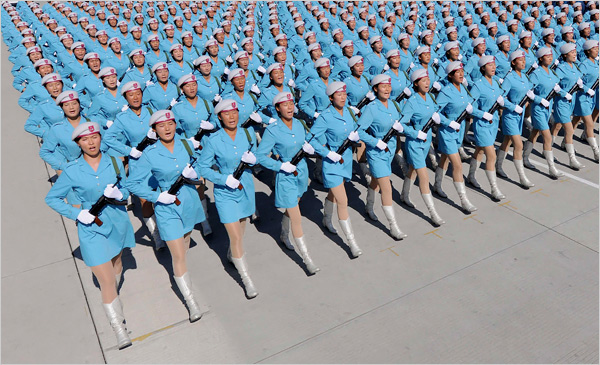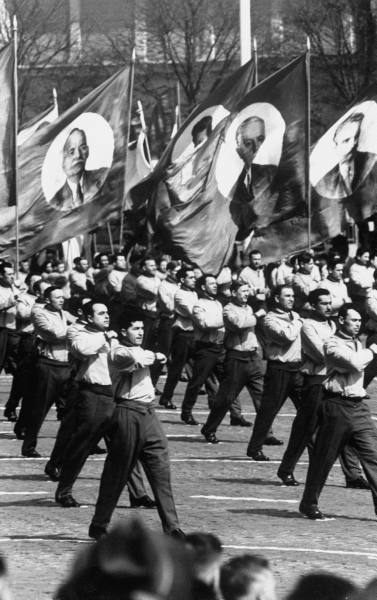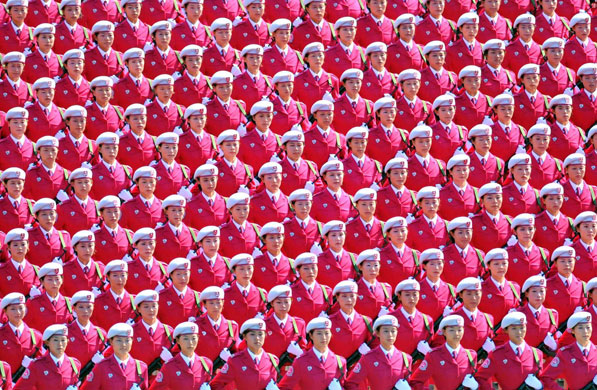Like the recent Olympics, the 60th anniversary of the People’s Republic of China has supplied spectacular images of brightly colored, state-sponsored performance art on a grand scale. Many of the photographs are of military troops marching on parade.

Something seems to be lost in translation, however, as what we see here is a far cry from the amateurism and informality of a typical Fourth of July parade in the U.S. A better comparison would be with an Army drill team–if the U.S. Army drill teams had 10,000 troops.
These massive formations of perfectly entrained, tightly choreographed, visually striking troops embody design principles seen throughout Chinese public arts–again, think of the many displays of common movement at the Olympics. Given the work that goes into it, the performers must take great pride in what they do, and from comments at photo blogs it seems that Chinese spectators around the world really like what they see.
But what do you see if you are not Chinese? I confess to being somewhat baffled by these images, not least because I can’t help but see them as the latest iteration of the Victory Day parades in Moscow during the Soviet era. That is, I have the ideological reaction that I was supposed to have when being shown these images in the U.S. press at the time: I see the totalitarian state revealing itself all too clearly in its supposed show of force. Where the Soviets or the Chinese want us to see massed might, we see the state using enforced conformity to crush freedom and individual expression.
LIFE, Time, and other media outlets loved to shoot the Victory Day/May Day parades, and no wonder.

Today, it looks shabby, perhaps even comical, but at the time it was seen as the work of a state using all its resources to mold Mass Man. The USSR is gone, but the Cold War interpretive framework is maintained by shots of marching troops in North Korea and elsewhere. (Russia continues the tradition as well, but coverage now is more varied.) And if that isn’t enough, there still are movies of goose-stepping Nazis, which probably is where the visual convention started.
But are the Chinese formations living monuments to conformity? Is the authoritarian reality behind Chinese capitalism being revealed–worse, is it being made appealing through their production of the visual spectacle?

I think the answer probably is, in a word, “no.” Public art does not have one style, different nations share some conventions but also draw on unique cultural traditions, and in any case times change. The ideological categories of the cold war are not completely out of date, but they are about as good as cars from the same era. Rather than hazard a reading, I’d rather ask others what they see, whether they like the images, and why. Even so, I can’t shake my basic reaction and think that, for all the progress that China is making economically, they still are experiencing something like culture lag when it comes to fashioning civic performances to articulate their version of modern development.
Of course, one of the characteristics of the new China is that they can set their own fashions, thank you very much.
Photographs by Joe Chan/Reuters, Howard Sochurek/Life, Sipa Press/Rex Features.
FYI Just looked at a short video of the parade on vimeo – lots of guns etc but also lots of other parading – maybe we just get to see the guns in our press and of course the women soldiers here in slow motion and not the other stuff… the link http://vimeo.com/6853452 (shot on canon7d)
I watched the parade from my apartment in Hangzhou, and it was certainly an impressive display of state power. But a couple of modifiers-
1. From talking with ordinary Chinese, and from e-mails from students, there is a genuine pride and love of country that is reflected in the parade. The parade was meant for Chinese consumption, not for analysis by foreigners. The parade did start with the display of troops, and move on to the hardware, but as Robert van Koesveld points out, these were followed by hours, or kilometers, of celebrations of economic and social achievement- the maglev train from Pudong to Shanghai, the space walk last summer, lots of ethnic groups dancing, city development. I don’t know what got shown on tv in the US, but the parade was impressive at both ends.
2. Before national day there were plenty of anniversary celebrations across the country, mostly organized by local governments, just as the fourth of July parades are. These events were always as grand a spectacle as could be produced for the time and money, I would guess, and many were very impressive. They involved singing, individually and in large groups, dance and acrobatic performances, ethnic dances and poetry. At my school, as I guess was the case at others, we had the annual national day singing competition, in which school departments compete for best performance in front of hundreds of other students. The students were enthusiastic about this- no bored guys in the back row looking up at the stage lights. Everybody took part, with gusto. The singing competition is a show put on for the students, by students. For themselves. Every year, the Chinese government officials at IIT, my school in Chicago, put on a new year celebration that involves hours and hours of practicing- skits, comedy routines, singing. This is a show put together by about 30 people for their own pleasure and consumption. Americans would never do this.
I want to say that there is a love of spectacle here, but someone more knowledgeable than I should make that argument. But it is the case that Chinese love doing things in big groups, and that is cultural, I think, not something created 60 years ago.
So I think Bob Hariman is right. There is a wysiwyg quality to parade criticism. When I talk in class about the Prisoner’s Dilemma game, there is a different reaction here than in the US, where we say the game suggest that cooperative solutions can be better than individualistic ones. At least one Chinese book suggests that the game shows the faults of individualism. A subtle difference perhaps, maybe even mangled in translation, but that I what I found.
My guess is that our informal displays of military related themes in parades in the US are functions of both money and interest. If you offered the local government more money to do a bigger parade, I bet they would do it, and include the military piece in the “improvement.” But I like the fourth of July parade in Evanston, where I live (used to?) in all its fairly disorderly and low key feel. To Chinese, that parade looks amateurish. And with regard to changes in the manner of Chinese display, I am not sure anyone wants to see 1.3 billion people running around in a disorganized way. In a country that was considered to have a hydrologic-based empire (like Egypt), a long standing concern about feeding people, a palpable concern about too many people and not enough land, civic order is a high good.
Western media commentary about China’s one child per couple policy has tended to criticise it, and given the impression that because boys were more desirable culturally that there were less girls, so what immediately struck me about the two parade photos featured here is that they are both of large numbers of young women.
For USSR nostalgia, there’s also North Korean TV news, in the snippets occasionally broadcast in South Korea. I can’t find it on YouTube, but the clip that most sticks in my mind shows a road construction project with hundreds and hundreds of smiling, spotlessly clean workers milling around a single Japanese backhoe. At lunchtime the workers “spontaneously” group themselves into a kind of Last Supper linear tableau on either side of their smiling, head-tossing leader, and then they’re serenaded by a military band.
The video was in color, but with that sole exception it was Stalinist iconography in absolutely pure culture, preserved completely unchanged — clothes and all, complete with pigtails on the girl musicians in the band — from the 1930s. Visualize the Kazakh national anthem at the end of _Borat_.
I was glad to read Bob Markel’s comments, because what struck me immediately was that these images were not a show of military force, as the military parades with which we might be familiar–U.S. (including base parades for the brass, not just public parades) or Nazi displays from history….because the women’s attire could not possibly be utilitarian uniforms. Silver boots and miniskirts? Hot pink jackets? Not even dress uniforms, these must have some more ceremonial/cultural display purpose. No equivilant in U.S. military. So Markel’s comments added some fascinating context to what were for me rather mystifying gendered images.
fwiw I would compare these images with a likewise aerial shot of the masses in bumper -to- bumper traffic on any American freeway.
“But are [these] Chinese formations living monuments to conformity?” imho This is China looking through their rear-view mirror ~ the irony is that modern Chinese pedestrians’ costumes are quite diverse, much moreso than in America, which (ironically) has settled upon that blue drab conformity of (I daresay unisexual) denim slacks and 3rd World sweatshop cotton gym clothing tops with rubber shoes (and… baseball caps?). iow, We are much more conforming today than China; we just live in this illusion that we remain “individuals,” but we long ago lost that privilege of being “customers,” as in “the customer is always right.” We are all “consumers” now, if not mere “metrics.” Indeed, we are no longer one man, one vote ~ rather, we are clumped into democratic “voting blocs.” Notions of “masses” and “conformity” can be quite deceiving when reduced to only 2 dimensions. Whenever I travel to the Far East I am always amused when, after a few drinks, they tell me that “You Americans have too much freedom!” After Medical insurance (not unlike automobile insurance) becomes compulsory, will we smile whenever we hear the phrase: “Show me your papers”-?
chinese girls so cute